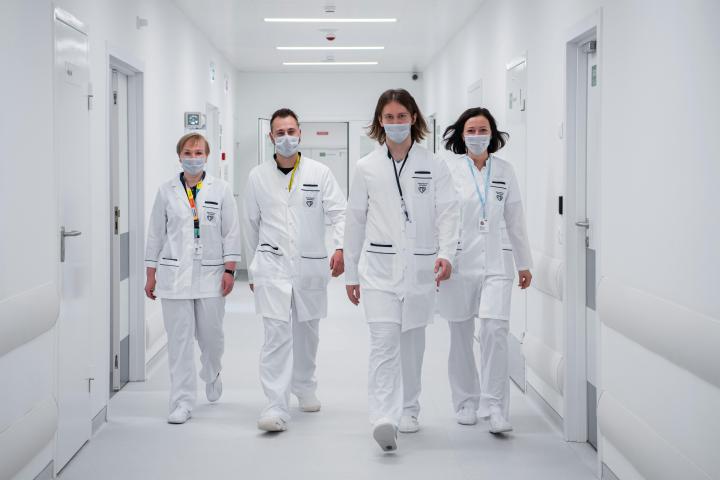
Healthcare Insights: Doctors Are Organizing
John August
In the contemporary moment, headlines nearly every day are full of stories about labor, labor organizing, labor actions, and labor strikes. A recent article which appeared in the New York Times adds to the landscape, as it goes deep into many of the root causes which explain why doctors and other healthcare professionals are speaking out and organizing.
In October, 600 doctors and other professionals won a union election decisively, voting for representation with Doctors Council SEIU. The doctors work for Allina Health a large multi-billion-dollar health system in Minnesota. That victory is a major focus of the Times article. The successful organizing drive highlighted issues that are emerging across the nation for doctors who work in hospitals, clinics, emergency rooms, more and more of whom are directly employed by large corporations and private equity firms.
Quoting from the article:
“The reasons for the recent labor actions appear straightforward. Doctors, nurses and pharmacists said they were being asked to do more as staffing dwindles, leading to exhaustion and anxiety about putting patients at risk. Many said that they were stretched to the limit after the pandemic began, and that their work demands never fully subsided.
But in each case, the explanation runs deeper : A longer-term consolidation of health care companies has left workers feeling powerless in big bureaucracies. They say the trend has left them with little room to exercise their professional judgment.
For years, many doctors and pharmacists believed they stood largely outside the traditional management-labor hierarchy. Now, they feel smothered by it. The result is a growing worker consciousness among people who haven't always exhibited one - a sense that they are subordinates constantly at odds with their overseers.
I realized at end of the day that all of us are workers, no matter how elite we’re perceived to be,” said Dr. Alia Sharif, a colleague of Dr. Wust’s at Allina who was heavily involved in the union campaign.”
In this month’s Healthcare Insights, I want to build on last month’s article which suggests that for healthcare workers and workers in other sectors of the economy to be successful, new forms of organization and collective bargaining are likely going to be needed:
The current wave of worker militancy in healthcare ought to be seen as an opportunity, even a necessity to extend worker voice across the nation. The issues driving militancy will not be resolved system-by-system, facility-by-facility, or negotiation-by-negotiation since the underlying issues impact the industry and the workforce as a whole.
Traditional collective bargaining and non-union sectors will continue to exist for the foreseeable future. It will likely take a long time for new ideas and experimentation with collective problem-solving, mutual interest, and mutual gain to take hold. There is a long history to overcome.
However, there is a new movement afoot that may change the dynamic in unforeseen ways: physicians are clamoring for unionization. To say that the unions’ telephones are “ringing off the hook” from physicians all over the country looking to unionize would be a real understatement.
I suggest it is pretty clear that a new day is upon us.
What is the “new day”?
It is certainly NOT a new phenomenon that workers want to organize when, as stated in the article above that “For years, many doctors and pharmacists believed they stood largely outside the traditional management-labor hierarchy. Now, they feel smothered by it. The result is a growing worker consciousness among people who haven’t always exhibited one — a sense that they are subordinates constantly at odds with their overseers.”
Doctors face much the same reality that workers in general face as they confront this near universal reality of not having a voice when it comes to the work that they do: they have little to no collective power. With private sector union density at 5% of the workforce, it seems clear that traditional forms of organizing and collective bargaining will take far too long to achieve the power necessary to impact their lack of voice and what to do with it once attained. Of the nearly 1 million doctors in the United States, 5-7 % belong to traditional unions, and most of them are in the public sector. To say that doctors in the private sector lack collective power is abundantly clear.
What is new and happening among doctors that is not happening as quickly in other sectors is that doctors are finding their voice. In this column, I reported on the voices of well-known doctors writing in major publications about the need to organize.
There are a growing number of doctor-led organizations that call for doctors to unify around what is called Corporate Practice of Medicine (CPOM). Recently I spoke with one of the founders of an organization called Take Medicine Back.
Here is what I learned or had confirmed from doctors in that conversation:
- As the trend of doctors practicing medicine as independent practitioners has led to more and more of them now working for health systems as employees, in group practices that have been purchased by for-profit corporations and private equity, and many similar situations, doctors have lost their ability to exercise their independent judgement in the practice of medicine.
- Doctors who speak up are being fired with no recourse (you can read of an important case on the Take Back Medicine website).
- Most important is a growing recognition of what CPOM actually is and that it is not just a rhetorical slogan: rather CPOM is the system that has emerged for healthcare in the United States which must be understood and dismantled according to the Take Medicine Back working paper entitled “The Corporate Practice of Medicine”.
Take Medicine Back’s paper suggests:
“Physicians’ organizations must collectively reject the corporate ownership of medical practice. Reclaiming the profession from corporate interests will take time, and greater protections for employed physicians are needed now in order to protect patients. In the face of legislative inaction at the state and federal level, employed physicians should use the tools available to labor, and organize through unionization.”
In the last few weeks, since the New York Times article of December 3, 2023 appeared, I have had more conversations with doctors seeking advice or expressing interest in unionization. All of the conversations have the same theme, doctors report that they have experienced a loss of control over their medical practice:
- Two doctors, one from the west coast and one from the east coast who did not know each other told identical stories about how long-standing large and well-respected medical group practices in which they were partners were purchased by the same national for-profit entity. They experienced staffing reductions, new compensation models which reduced their incomes with no transparency about how or why these systems were put in place, and among the results of the corporate takeover included doctors leaving the practice after decades of service.
- Another directed me to the following article: Written by a prominent radiologist, among other insights included in the article: “Increase physicians’ responsibility while decreasing their authority. For example, hold physicians responsible for patient satisfaction scores, but ensure that such scores are influenced by a variety of factors over which physicians have little or no control, such as information technology, hospitality of staff members, and parking. The goal of such measures is to induce a state that psychologists refer to as “learned helplessness,” a growing sense among physicians that whatever they do, they cannot meaningfully influence healthcare, which is to say the operations of the hospital.
Above all, introduce barriers between physicians and their patients. The more directly physicians and patients feel connected to one another, the greater the threat to the hospital’s control.
It does appear that doctors are finding their voice, and the themes that drive the need to develop a collective voice are quite common as seen in union organizing drives, in the new literature of doctor-led critique of the medical system, and the emergence of many new organizations to unify doctors around these themes:
- Loss of control over the doctor-patient relationship
- The causes of that loss of control of the doctor-patient relationship include the rapid increase of intervention of non-medical decision-making into the actual practice of medicine, insurance company decision-making about medical decisions, for-profit purchases of medical practices, more and more consolidated health systems, and private equity takeover of medical practice and delivery systems.
- Deep moral injury and burnout
What is both intriguing about all of this and at the same time practically challenging is that while there is an emerging consensus among the majority of doctors in the nation that gaining collective voice is essential for themselves and their patients, there are several categories of doctors within that consensus, categories which make traditional union organizing very difficult:
- Those who are both eligible to unionize and who wish to do so (recent data tells us that a slight majority favor unionization, but many still do not see that as the top choice to achieve a collective voice).
- Those who remain in private practice and are independent contractors, not eligible for unionization.
- Those who hold management or other high-level positions in hospitals, health systems, and in academic medicine, but agree with the need for a collective voice to restore the doctor-patient relationship and protect the profession.
A new model for organizing and collective bargaining ought to emerge from these challenges that has at least three connected component parts:
- Traditional collective bargaining for those who attain it limits the dialogue to wages, hours, working conditions, and conditions of employment which are generally narrow in scope. In order for collective bargaining to address the issues and dynamics that has brought doctors to call for action, collective bargaining must transform as well. We have models for this as established in the Kaiser Permanente Labor-Management Partnership which relies on interest-based bargaining which requires the parties to identify mutual interest and solve problems which include the major drivers of healthcare outcomes all focused on the needs of patients: quality, patient experience, affordability, while ensuring the best place to work.
- Unified legislative and regulatory efforts to re-shape the dominance of the corporate practice of medicine in the public interest
- Unified public education and awareness of the leadership role that doctors are taking on behalf of patients and their profession
I will call this an “umbrella organization”: unifying people in an industry through new forms of collective bargaining, government action, and public education and enhanced public awareness of how such organization is in the public interest.
As doctors and their fellow healthcare colleagues continue to seek collective voice we must pay close attention to the forms of organization, communication, and engagement with healthcare industry decision-makers. As in other sectors of the economy where unionization and collective voice are at all time lows, innovation and new ideas will likely emerge for worker organization as well.
While not entirely new as an idea, it would be a new dynamic in organizing for there to develop national “umbrella organizations” like that which may be emerging among doctors now.
This is how I think about a new day.
John August is the Scheinman Institute’s Director of Healthcare and Partner Programs. His expertise in healthcare and labor relations spans 40 years. John previously served as the Executive Director of the Coalition of Kaiser Permanente Unions from April 2006 until July 2013. With revenues of 88 billion dollars and over 300,000 employees, Kaiser is one of the largest healthcare plans in the US. While serving as Executive Director of the Coalition, John was the co-chair of the Labor-Management Partnership at Kaiser Permanente, the largest, most complex, and most successful labor-management partnership in U.S. history. He also led the Coalition as chief negotiator in three successful rounds of National Bargaining in 2008, 2010, and 2012 on behalf of 100,000 members of the Coalition.



